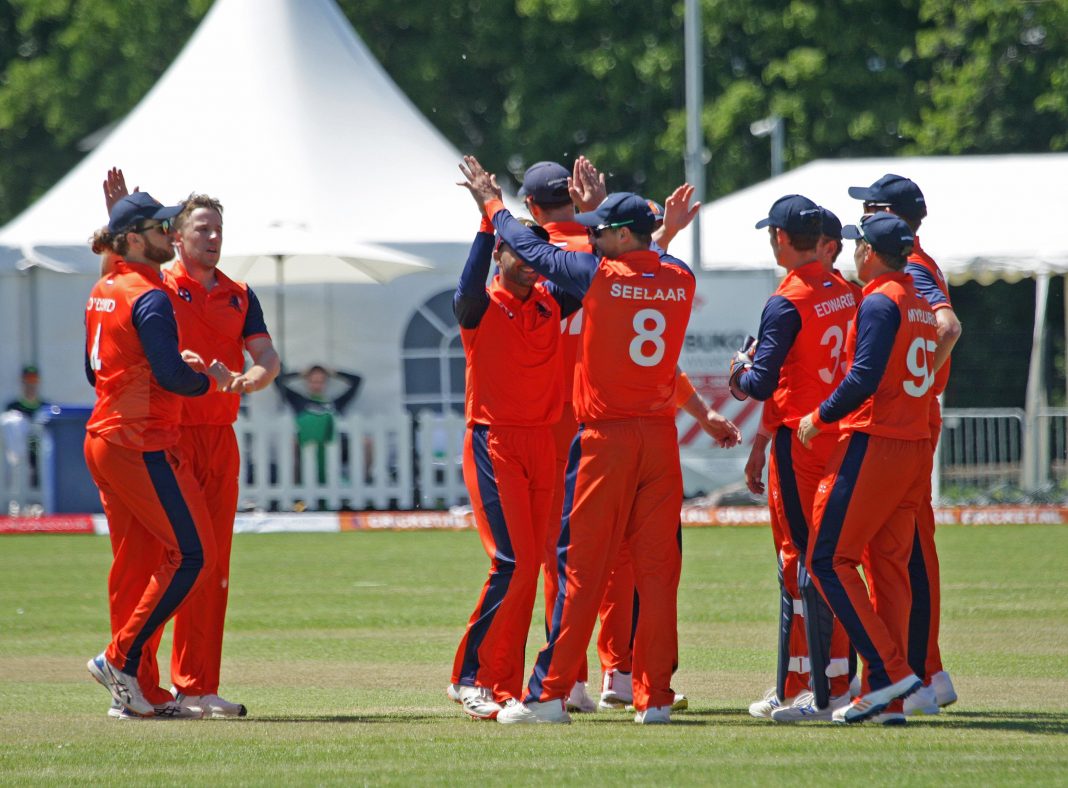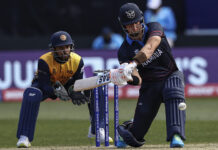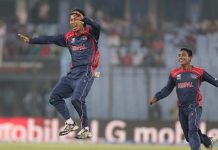By Abraham Abhishek
“We are getting better, and we are coming for the bigger teams,” said Dutch men’s captain Peter Seelaar in an interview in May 2018, looking forward to the Cricket World Cup Super League 2020-22 for which Netherlands had qualified by winning the 2015-2017 World Cricket League Championship.
It was a landmark in Dutch cricket history – the men in orange had regained ODI status after four years. Thanks to the Super League, they were guaranteed 24 ODI fixtures over two years, including several against Full Member teams. Even without the Super League, the team would have had a shot at qualifying for the 2024 ODI World Cup through League 2 and the Challenge League. But for the first time ever, there was a two-year outlook with substantial international cricket, and substantial resources to build a team along the way.
It was an interesting time to start following Dutch cricket having lived in a small town in The Netherlands for eight years, and was on the verge of becoming a Dutch citizen. There was optimism in the air, and frequent invocations of matches when Netherlands upset Full Members (like England at the 2009 T20 World Cup, Ireland in 2013) or gave them a bloody nose. Of course, outside the small cricket community here (there are around 6000 active cricketers playing at various levels), nobody had the faintest idea – friends and colleagues were often surprised to hear that Netherlands had a national cricket team.
The mood soured as the Super League got off to a false start. Covid struck in 2020, and matches were cancelled. While the bigger teams could play each other in bio-bubbles, it was not an option for less endowed boards such as Netherlands. Netherlands’ Super League did not start until June 2021. There was no cricket between November 2019 until April 2021, when they travelled to Nepal for a tri-series against Nepal and Malaysia. That was a depressing, purgatorial period for the team – as it was for the rest of the world. The players’ mental health suffered.
“Players in their late 20s and 30s have lost more than a year of their peak years,” coach Ryan Campbell said in January 2021. “We have split the squad into groups of 4-5, with each one assigned to a member of the coaching staff. This way, we can have more one-on-one contact. We have an app on our phones that players can use to share how they are feeling on a daily basis, both physically and mentally.”
Then came the 2021 T20 World Cup, where Netherlands failed to go past the First Round into the main draw, getting bundled out for 106 and 44 against Ireland and Sri Lanka respectively in the process. The lack of game time was writ large over their performance, and that of other Associate nations. This was a different format, but the team’s performances were so dismal, fans started doubting whether the team deserved its provisional ODI status.
The team’s official tournament shirt was bought with much enthusiasm and in anticipation of some upsets and moments of brilliance, which the Dutch had never failed to serve in past World Cup appearances. It is a beautiful shirt, but with it came associating it with the misery of the tournament and haven’t touched it ever since.
2022 was a landmark year. For starters, there was a lot of cricket – 15 ODIs and 15 T20Is. This was fewer ODIs than in the original ODI Super League plan. Nevertheless, the Dutch got to play bilateral series against full member teams—Afghanistan, Ireland, New Zealand, West Indies, England, and Pakistan. The latter three were part of the Super League. They were played at home, so fans got to watch Dutch players go up against the best in the world, all summer. To top it all, there was the glorious 2022 T20 World Cup: after a strong showing in the first round to qualify to for the main tournament, the Dutch beat Zimbabwe and South Africa, gave Bangladesh a scare, and held their own against India. In the process, they qualified directly for the 2024 edition of the tournament.
According to Dutch cricket journalist Bertus de Jong, the biggest positive from this historic year was the number of young, home-grown players that came through. “Bas de Leede, Vikram Singh, and Aryan Dutt for example…compared to where they were a year or two ago, to the point where Bas is arguably Netherlands’ best player at this stage…it is quite remarkable,” Bertus said in November 2022. “The amount of game time they had in the summer against full member teams played a huge role in their development.”
Bertus knows these players well. Along with associates and Emerging Cricket’s own Rod Lyall and Sander Tholen, he runs TKcricket.com, home to stats, blogs, editorials, and images that make for the most comprehensive coverage of Topklasse – the highest level domestic cricket tournament in The Netherlands (50-over).
He pointed out that the younger players got an extended run against top teams as many top players had competing commitments, such as domestic cricket in England. This is a feature, not a bug that appeared in 2022. “This is an issue across Associate teams…but the Dutch case is more extreme, as they have such a large number of players contracted elsewhere. 5-6 players are consistently unavailable for a majority of the matches,” he said. Unfortunate as this is, it is difficult to blame professional athletes for making choices that maximize their earnings during their short careers.
All this Super League cricket was leading up to the 2023 World Cup in India. This was not the first time Netherlands had rocked up to an ODI World Cup in this part of the world, but it was the first time since the national team had achieved a degree of professionalization.
“After the 2011 World Cup, 6 players were offered contracts. That was a first,” recalled Mudassar Bukhari, a key member of that team who has taken 100 wickets for The Netherlands in that format. “Before that, we got a stipend of 50-60 Euros on match/travel days. After the contracts, we were asked to come to practice, follow a fitness regime.”
“The guys who are paid to be full time cricketers…we cannot complain about having to come to a training at seven in the morning, or doing an extra gym session,” said Bas de Leede on the eve of the ODI series against Pakistan in August 2022, in Rotterdam. “Back in the day, my father (former Netherlands international Tim) had to do it on his own time, for little to no money. And now, we have a physio, a nutritionist, an SSC coach.”
The younger de Leede and his teammates had a World Cup to remember. They beat South Africa and Bangladesh, and gave Sri Lanka and Pakistan run for their money. In the process, they made many fans from across the cricket world. The team’s performance made a splash even back home in The Netherlands. The matches were reported in all major papers and discussed on talk shows and podcasts. The last two matches were even broadcast on the national broadcaster- NOS – with Dutch commentary.
Putting on the evening news and hearing the newscaster report the day’s play was also a lesson in how to use cricketing terms within the syntax of Dutch grammar. We would think about which terms needed translation, and which ones were best used as is.
“In Afrikaans, they call it Beenkie voor Paalkie,” said Ed van Nierop, commentator and former manager of the national men’s team, scratching his head as I asked how Leg Before Wicket would translate into cousin language Dutch. Ed called the action on the Dutch broadcast of the matches against England and India. He chose to go with the English term. “Through the legs…you don’t see that very often,” explained another commentator on-air for the benefit of newer fans, as a Logan van Beek delivery kept low and slid through the legs of a reverse-scooping Joe Root and into the stumps.
For Dutch cricket fans, this was all surreal.
“We are getting better, and we are coming for the bigger teams,” Seelaar said casting back to that chat on an afternoon at Voorburg Cricket Club in 2018. Six and a half years, one global pandemic, a glorious ‘Summer of Cricket,’ several losses and many moments of doubt later, the Dutch men’s team rounded off their Super League journey with a performance that was probably exactly what they had hoped for.
Life is no fairy tale, and that’s probably why the two men at the helm at the beginning of the voyage could not see it all the way through – captain Seelaar hung his boots in 2022 due to persistent back injuries; coach Campbell called it a day after the much-praised 2022 T20 World Cup campaign.
For this fan too, this marks the end of a journey.
Older and ageing, this author is as invested in Dutch cricket as ever, cheering on the men in orange as they navigate the League Two and the Qualifier to find a way to the 2027 World Cup, and hopefully through a couple of T20 World Cups on the way. It could be a story every bit as exciting, but it will be a different one.
EPILOGUE: As soon as the ODI WC was over in November, Netherlands got down to preparing for the 2024 T20 WC in June 2024. This involved matches against SA20 sides in South Africa in January; and a tri-series against Nepal and Namibia in Nepal, in February 2024. There were talks of a tri-series against Uganda and Oman in Uganda in March, but it fell through. All these teams will feature in the T20 WC. All these matches were organized last-minute, as they scrambled to get a minimum amount of match practice under their belt before the tournament.
The ICC noted the role the Super League played in the development of the Dutch men’s cricket team, and in boosting cricket in The Netherlands in general. The ICC has absolutely “…no doubt that the Super League was hugely helpful in terms of a pathway to Associate countries.” The ICC, under pressure from multiple big members, cancelled the Super League in September 2021.
Fans can submit stories, news tips and comments at emergingcricket@gmail.com
You’re reading Emerging Cricket — brought to you by a passionate group of volunteers with a vision for cricket to be a truly global sport, and a mission to inspire passion to grow the game.
Be sure to check out our homepage for all the latest news, please subscribe for regular updates, and follow EC on Twitter, Facebook, LinkedIn and YouTube.
Don’t know where to start? Check out our features list, country profiles, and subscribe to our podcast. Support us from US$2 a month — and get exclusive benefits, by becoming an EC Patron.







